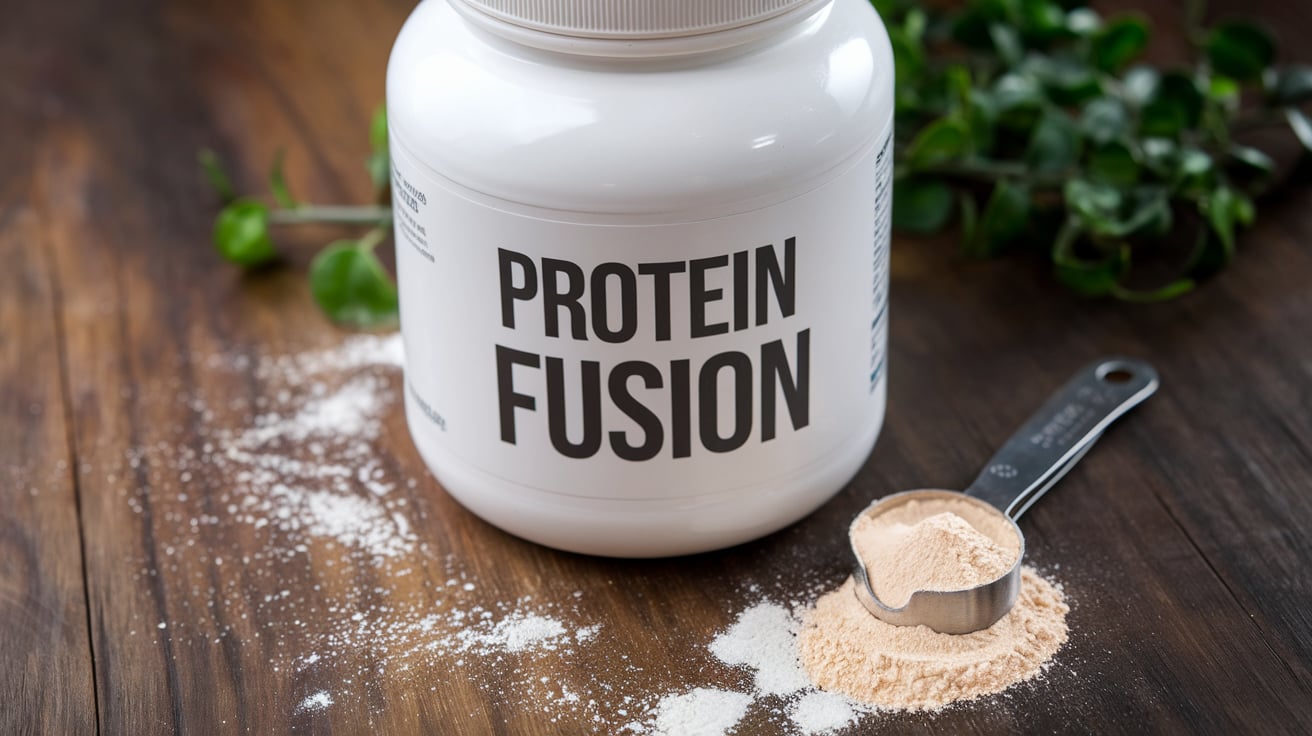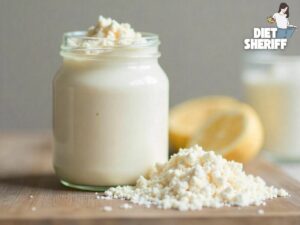Protein powder is becoming a necessary supplement for anybody who wants to gain muscle and heal from an injury.
Homemade protein powders is not that costly. But, you have to know how to make protein powder at home for muscle gain.
As an alternative, creating your own protein powder at home is a great way to maintain quality and composition control over your supplement.

Benefits of Making Protein Powder in Home
Making protein powder at home offers several advantages. The main benefits are as follows:
Control over Ingredients
You may select premium, organic and minimally processed products to make your own protein blend.
You may be sure that there are no unwelcome ingredients and preservatives in your protein powder.
Related Article: How Often Should You Take Protein Powder?
Customization
You may customize your protein powder to meet certain nutritional needs. This may be achieved by choosing the right sources of protein and other additives.
You may also freely customize the flavors and sweetness levels to fit your own tastes.
Cost Effectiveness
It might be less expensive to make protein powder at home, especially if you buy the components in bulk.
As opposed to many commercial protein powders, this approach lowers the cost per serving.
https://gigasecurehome.com/ring-live-view-not-working-on-android
What Ingredients are needed to Make Homemade Protein Powder for Muscle Gain?
Mixing several high-protein products together is the process of creating a homemade protein powder for building muscle.
Related Article: How to Use Protein Powder to Build Muscle?
The following are some typical components that you might use:
Protein Base
- Whey Protein Isolate: Contains low amounts of fat and lactose and at least 90% protein by weight.
- Casein Protein: Another protein from milk that is slowly digested to release amino acids over time.
- Plant-Based Protein: Protein powders made from peas, hemp, rice, and soy for a vegan alternative.
Some of them are also rich in omega-3 fatty acids and contain all of the necessary amino acids.
Additional Protein Sources
- Egg White Powder: They are a complete protein source with low in fat and high in protein.
- Collagen Peptides: Beneficial for joint health and supplies extra protein, they are not a complete protein.
Carbohydrates (Optional)
- Oats: Can be added complex carbs by grinding oats.
- Maltodextrin: A quick-digesting carb that can aid in the recovery of glycogen after exercise.
Related Article: Can You Make a Protein Shake the Night Before?
Healthy Fats (Optional for Additional Calories)
- Ground Flaxseeds: Ground flaxseeds, high in fiber and omega-3 fatty acids which can help heart health.
- Chia Seeds: These seeds consist of protein, fiber and good fats.
https://gigasecurehome.com/can-wyze-camera-connect-to-echo-show
Flavorings and Sweeteners
- Cocoa Powder: For more antioxidants and a chocolate taste.
- Vanilla Extract: Either pure vanilla extract nor powdered vanilla bean can be used to add taste.
- Stevia Fruit Extract: Sweeteners that are natural and low in calories help improve the flavor without adding extra calories.
Functional Additives
- Creatine: Increases muscular phosphocreatine reserves, which improves strength and muscle growth.
- Branched Chain Amino Acids (BCAAs): Lessens post-exercise muscular pain and promotes muscle repair.
- Maca Powder: Renowned for increasing stamina and maybe hormone balance.
- Spirulina: An algae, rich in nutrients that provide extra protein and additional micronutrients.
Basic Recipe Example
This is a detailed recipe as an answer for the question “how to make protein powder at home for muscle gain?”
Ingredients:
- Two cup of plant-based protein powder or a whey protein isolate
- One cup of powdered casein protein
- One cup of oats, powdered
- Half a cup of flaxseed meal
- One-fourth cup chia seeds
- One-fourth cup cocoa powder
- One tablespoon of essence from vanilla
- One spoonful of stevia
- Optional: A single tablespoon of creatine and two teaspoon of BCAAs
Related Article: Can You Put Protein Powder in Overnight Oats?
Instruction:
Mix Dry Ingredients:
Put the other protein powders and the whey protein isolate in a large mixing dish.
Include the optional functional supplements (BCAAs and creatine). Make sure that the dry ingredients are well combined.
Add Flavorings:
Stir and blend thoroughly until the vanilla essence is mixed into the powder all over.
Store:
Move the mixture into an airtight container. To preserve freshness and avoid clumping, store in a dry and cool place.
Using the Protein Powder
Mix 1-2 scoops (30–60 grams) of the homemade protein powder with the items that follow to make a protein shake:
- 8–12 ounces of milk, water, or use anything as substitute for milk.
- Blend the protein powder with fruits and other supplements to make a smoothie that has even more nutrients diet sheriff.
Customize the Protein Shake
- After tasting your protein powder combination, add extra stevia to make it a little sweeter.
- Try varying the tastes by including natural extracts, such protein powders with almond or coconut flavors.
- For added health advantages, try adding probiotics and extra fibers.
https://gigasecurehome.com/wyze-cam-v3-wont-say-ready-to-connect
Comparing Homemade Protein Powder to Commercial Options
There are a number of aspects to consider when comparing homemade protein powder to store-bought brands.
This is an in-depth comparison:
Cost
Homemade Protein Powder:
- Pros: Buying in bulk may result in a more affordable purchase. Certain ingredients, such as flaxseeds, oats, and protein powders can be bought cheaply.
- Cons: Purchasing specific materials in bulk may result in higher initial costs.
Commercial Protein Powder:
- Pros: Widely accessible at a range of pricing points, from high-end brands to affordable ones.
- Cons: It might be costly to purchase premium brands with superior ingredients. Purchasing expenses on a regular basis might mount up.
Ingredient Quality
Homemade Protein Powder:
- Pros: Enhance total control over the origins and quality of ingredients. People can be able to select minimally processed, organic, and non-GMO foods.
- Cons: The quality of the materials used to make homemade mixtures determines the final quality.
Commercial Protein Powder:
- Pros: Premium ingredients are used in many high-quality products, and they go through extensive testing.
Choices increases for clean label, non-GMO, and certified organic items.
- Cons: Certain products could utilize artificial sweeteners, fillers, and low-quality ingredients.
Customization
Homemade Protein Powder:
- Pros: Completely adaptable to dietary requirements and personal preferences. People can be able to modify fat, carb, and protein ratios.
- Cons: Requires effort to experiment with various recipes and quantities, in addition to nutrition knowledge.
Commercial Protein Powder:
- Pros: Wide range of pre-made alternatives to meet different needs. A variety of flavors to accommodate different tastes.
- Cons: Fewer options for customization in versus handmade. Trying a few different brands can be necessary to obtain the perfect fit.
Taste
Homemade Protein Powder:
- Pros: Able to precisely customize flavor to taste by varying flavorings and sweeteners.
- Cons: To get the right flavor and texture, it could take some trials. Mixtures created at home might not blend as smoothly as powders from stores.
Commercial Protein Powder:
- Pros: Professionally prepared for a constant flavor and texture; available in a range of tastes.
- Cons: Artificial sweeteners might not be to everyone’s taste. Tastes might differ greatly between brands.
Convenience
Homemade Protein Powder:
- Pros: Can be used and stored just as simply as commercial powders once combined.
- Cons: The initial time investment to gather components and make the mixture. Requires careful storage in order to keep its freshness.
Commercial Protein Powder:
- Pros: Incredibly practical; requires no preparation and is ready to use.
- Cons: Dependency on the reliable availability of favored tastes and brands.
Health Benefits or Drawbacks
Homemade Protein Powder:
- Pros: Ensuring complete control over every ingredient ensures the absence of undesired additives.
Can be added particular nutrients to improve health benefits.
- Cons: Possibility of contamination in the event that ingredients are not supplied as well as preserved correctly.
Commercial Protein Powder:
- Pros: Scientifically proven formulas for maximum health advantages are available in many respectable brands.
- Cons: If not thoroughly checked, certain items may contain allergies.
Explore Also:
Creativehouseblog
Gigasecurehome
Mycleanseplan
How to Make Protein Powder at Home for Muscle Gain- FAQs
How should homemade protein powder be stored?
Keep in a dry and cold location in an airtight container.
Can I bake using homemade protein powder?
Yes.
How can I ensure that my protein powder blends smoothly into liquids?
To create a smooth consistency, ground all components finely and mix with liquids using a blender.
What is the shelf life of homemade protein powder?
You can store homemade protein powder for several months.
When adding protein, is it okay to add raw egg whites?
Use pasteurized egg white powder instead of raw eggs.






